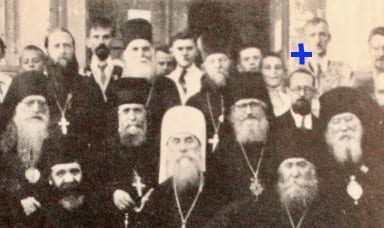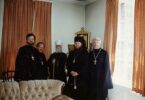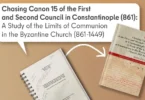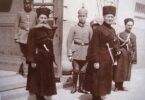It is the first reference to the apocryphal Canon 19 of Timothy of Alexandria in the Russian Church Abroad. This canon was used as a canonical argument to change the practice of the reception of the non-Orthodox in the Russian Church Abroad in 1971. Translated by Margaret L. Jernic. It first appeared, in English, as item Nr 28 in the St Nectarios Educational Series, published by the St Nectarios American Orthodox Church in Seattle, WA, USA.
In the pages of the Paris journal The Way [Put’], one could often read about the supposed perniciousness of the “Byzantine Period” in the life of the Church. Then in their books, the contributors to this journal began to criticize the doctrine of the Holy Fathers, even those such as Sts Athanasios the Great and Cyril of Alexandria (Archpriests Bulgakov and Kartashev). Now one can see that the criticism of the Paris theologians has begun to reach even further back into antiquity, and N. Zernov — who recently received his doctorate from Oxford University — has published an analysis of the doctrine of St Cyprian in an article entitled “St Cyprian of Carthage and the Unity of the Ecumenical Church.” Contrasting the period before Cyprian with the one after, he accuses the Holy Father of errors which, in his words, had an extremely harmful effect on the subsequent life of the Ecumenical Church, and were in part responsible for bringing the Church of Carthage to ruin.
Zernov’s article is so characteristic of a man who has been spiritually nurtured by the interconfessionalism of the West, it is full of such gross errors which are unpardonable in an Orthodox doctor of theology (who, even though he received his degree from a heterodox university, has also finished studies under an Orthodox theological faculty), that it is worthwhile to examine it.
The author begins with the statement that the most recent striving for unity which has appeared in the separate contemporary confessions “places before the Orthodox consciousness a most crucial task—that of defining with precision not only the essence of the Ecumenical Church but also her visible boundaries.” Orthodoxy, in his words, possesses extremely rich material for this — however, not systematized by “the catholic consciousness of the Church. The writing of the Holy Fathers, the canons of the councils offer various attempts to find an answer to the question of Church unity. They are often not only in disagreement, but sometimes even contradict each other.” Orthodoxy, in consequence, “has no ready answers to the series of enquiries belonging to our time, and does not solve those new perplexities and problems which characterise the mutual relations of the Churches in the twentieth century.” Then the author begins an exposition and criticism of St Cyprian’s doctrine of the Church. But before we move on to this criticism, we will say a few words about the propositions quoted above.
Unfortunately, the author does not point out what those new problems and perplexities are which are characteristic of the mutual relations of the churches in the twentieth century. It would seem, however, that here it is to be borne in mind that the confessions which in their day fell away from Roman Catholicism are now declaring their friendliness to, and esteem for, the Orthodox Church. Instead of controversy and recriminations, friendly greetings are heard on both sides, and indications of a truly very touching concern sometimes appear. Herein lies the difference between the present era and that of the Ecumenical Councils, when it was usual for non-Orthodox confessions of faith to struggle fiercely with the Eastern Church, and when, confronting confessions alien to the Church, the Church employed only the language of refutation and the exhortation to be united to the One, Holy, Catholic, and Apostolic Church.
In spite of N. Zernov’s rather bold statement, it is impossible to find in the works of the Holy Fathers or in the Holy Canons contradictions in the doctrine of the unity of the Church. From the most ancient times, beginning with the words of the Apostle, “One Lord, one faith, one baptism” (Eph .4:5), Orthodox Christians have confessed that there is only one true Church, to which the promise has been given that “the gates of hell shall not prevail against it” (Mt. 16:18). And we also think that no matter how hard N. Zernov tries, he will not find this notion contradicted either in the works of the Holy Fathers or in the Holy Canons.
In prescribing, for various situations, three modes of being joined to the Church — sometimes through baptism, sometimes through the renunciation of heresy and chrismation, at other times simply through repentance — the Holy Canons and all the Holy Fathers consistently support the conclusion that only the Orthodox Church unites with Christ and saves, whereas all other confessions are deprived of grace-giving and saving mysteries. Therefore, the canons call those who are united to the Orthodox Church “those of the number of the heretics who are saved” (Canon 7 of the Second Ecumenical Council; Canon 95 of the Council in Trullo). Likewise, the differing practices employed in uniting heretics to the Church do not in the least alter the eternal doctrine of the Orthodox Church that she alone Is true, saving, and “the dove [Song of Songs 2:14], and the unique mother of Christians, and [that it is she] in whom all the eternal and lifegiving mysteries are received to salvation, and who subjects those who are in heresy to great censure and punishment” (Canon 68 of the Council of Carthage).[1] BOOK OF CANONS (In Russian). This doctrine is expressed with particular vigor in the 46th Canon of the Holy Apostles: “We order that a bishop or presbyter who has accepted the baptism or sacrifice of heretics to be cast out. What concord has Christ with Belial? Or what part has a believer with an unbeliever?”
In the Kormchaia Kniga [“Book of the Helmsman”], in the “Canonical Answers of St. Timothy, Archbishop of Alexandria,” we find an authoritative explanation of the fact that reception into communion without baptism is neither a contradiction of that doctrine nor an admission by the Church of the grace of the baptism (and consequently of the other religious rites) of heretics, but only an exceptional order of uniting those people to the Church whom the prospect of repeating the baptismal rite might alienate from Orthodoxy. To the question, “Why do we not baptize heretics who turn to the Catholic Church?”, St Timothy answers: “if this were done, hardly any man would turn from heresy, since he would be embarrassed by the baptism; however, the Holy Spirit can also come by the laying-on of the priest’s hand, and by prayer, as the Acts of the Holy Apostles bear witness” (Kormchaia Kniga, Ch. 60).[2] compare A.S. Khomiakov in his third letter to Palmer, where he says that by making peace with the Church, “the imperfect heretical rite receives perfection and fulness.” One must believe that Timothy of Alexandria, who took an active part in the Second Ecumenical Council, is fully authoritative in explaining a principle which lay at the foundation of the seven canons of that Council. It ought to be pointed out that even St Cyprian, a defender of uncompromising procedure as regards the uniting of heretics to the Church, admitted the possibility, from a dogmatic point of view, of their being united to the Church without rebaptism: “But someone will say, ‘What will happen to those who before this turned from heresy to the Church, and were received into the Church without baptism?’ The Lord in His mercy is able to grant them forgiveness, and those who have been received into the Church and who fell asleep in the Church He does not deprive of the gifts of His Church” (Epistle to Jubaianus, Works, Kiev Theological Academy, 1891, Vol. 1, p. 347 [Ante-Nicene Fathers, Vol. 5, p. 385]). Although St Cyprian admitted that to introduce such leniency was dogmatically permissible, he thought, nevertheless, that in practice it should not be allowed as a norm because on account of it belief in the Church as the unique custodian of grace would be weakened — since “there will be no reason, for the heretics to turn to us when, since they have baptism, they think they have all the rest. On the contrary, when they learn that outside the Church there is no baptism and that remission of sins cannot be granted, they will the more eagerly and quickly come to us and will humbly ask for the treasures and gifts of Mother Church, knowing that they absolutely cannot attain the true promise of divine grace if they do not turn first to the true Church” (Ibid., p, 348 [Ante-Nicene Fathers, loc. cit.]).
The unity of the Church is uniformly confessed by the Apostles, the Holy Councils, and the Holy Fathers both before and after St Cyprian; and to tell the truth, it is only through prejudice that one could say there is any sort of contradiction to be found in this doctrine. It is a pity that N. Zernov left his assertion without proofs. In any case, to try to prove it would be wasted effort on his part.
But if we are convinced that only one of the groups which claim to be the Church is really the Church, we must answer the question: “Where is the Church?” On this point, N. Zernov claims that. St Cyprian made “a change in the area of the doctrine of the unity of the Church.” In what does this change consist? Not, he writes, in the claim that, only members of the Church can receive the saving gifts of the Holy Spirit — the author admits that “similar thoughts were widespread among Christians of that time” (we would say, however,
that such has always been the belief of the entire Church), but the “new element was his attempt to define with precision the visible boundaries of the One True Church. He taught that the earthly Church corresponds in full with the ecumenical brotherhood of those Christian communities which confess the true faith, preserve the moral instructions of the New Testament, and observe communion with each other… But since the understanding of true faith and high morality cannot be finally verified by human reason, St Cyprian sought some kind of criterion of the true Church that would be comprehensible to all; so, he joined a third sign, which he considered decisive, to the two foregoing — namely, the presence in the Church of the special institution of the episcopate, which was founded by Jesus Christ Himself and which received from Him the task of preserving the unity of the Church… Subordination to one’s lawful pastor became the objective guarantee of being in communion with the Holy Spirit — a guarantee which the Church before St Cyprian could not offer to Her members.” N. Zernov calls this doctrine “a grandiose reform in the life of the Church.”
But is this so? Is this a reform or is it St Cyprian’s statement of the original doctrine of the Church?
Let us turn to Apostolic times. Does not common sense tell us that if we were seeking the true Church among the various communities and confessions, we should seek the one which was in union with the Holy Apostles, who were chosen and taught by the Saviour Himself — with those Apostles to whom our Lord Jesus Christ said, “He that heareth you heareth Me” (Lk. 10:16)? And after their death, it would be natural, by applying the same criterion for finding the true Church, to recognize a union with their lawful successors. So it was in the ancient Church even before Cyprian. St Irenaeus of Lyons referred to the episcopate in succession from the Apostles as one of the signs of the true Church. He wrote, “We can enumerate the bishops who were appointed in Churches by the Apostles and their successors down to our own time, who taught and who knew nothing of what these heretics are raving about” (Against the Heresies, v. 3, 3:1), In another place, St Irenaeus unequivocally states the doctrine which N. Zernov reports as an innovation of St Cyprian: “So, where the gifts of the Lord are, there one ought to learn the truth, from those who have succession in the Church from the Apostles” (ibid., v. 4, 26:5). And Tertullian, who was then still Orthodox, writes of the heretics: “Let them declare a line of bishops which would be continued with a succession such that the first of the bishops would have as his inaugurator and predecessor one of the Apostles or one of the men of the Apostles who were for a long time connected with them. For this is exactly how the lists of the Apostolic Church are made. The Church of Smyrna, for example, presents Polycarp, enthroned by John; the Roman Church-Clement, ordained by Peter; in the same way, the other Churches point out those men elevated to the episcopate by the Apostles themselves, whom they had among themselves from the branches of the Apostolic seed” (Against the Heresies, 32). We advise N. Zernov to read the even earlier works of St Ignatius the God-bearer, who summoned the people to full obedience to the bishops with particular distinctness, saying that “where the bishop is, there the people should be, even as where Jesus Christ is. there also is the Catholic Church” (Ch. 7).[3]compare with many other pi aces in the same St Ignatios, and esp. the following: “Jesus Christ, our common life, is the thought of the Father, just as the bishops, placed to the ends of the … Continue reading Clement of Rome (1st Clem. 42 and 44) and many other Holy Fathers pointed to the hierarchy as the primary guardian of the truth, and consequently as one of the criteria for defining where the true Church is. And finally, this criterion received a most authoritative sanction from an Ecumenical Council when, among a number of other attributes and signs of the true Church, it was confessed that she is Apostolic.[4]It may be interesting, after the testimonies cited, to quote the conclusion of a well-known Anglican bishop and scholar, Dr Charles Gore, according to whose opinion the fact that the Church hierarchy … Continue reading
Zernov’s second error is that he ascribes to St Cyprian a teaching which is foreign to him, St Cyprian never taught that unity with the episcopate is the unique and decisive criterion in the definition of what it means to belong to the Church. He of course knew well that even bishops sometimes stray from the truth. But he had the norm in view. On earth nothing can be absolute. Thus the norm that to be in union with the Church one must be in union with a bishop is inapplicable when the bishop himself has fallen into heresy and has separated himself from the Church. But such a falling away is an abnormal phenomenon. St Cyprian reveals the norm when he writes about the union of the whole episcopate. In this case, he has in mind what should be, what the hierarchy should strive for. To think that he wanted to testify to a fact is in this case very naive.
Zernov writes much about St Cyprian’s teaching on the Apostle Peter as “the founder of the Ecumenical Church.” Is not this a little too strongly stated — the founder of the Church? I have found no such teaching by St Cyprian, but only a teaching on the Apostle Peter as the starting-point of the hierarchy. The founder of the Church, according to the teaching of the Saint, is our Lord Jesus Christ.[5] WORKS, pp. 100-101 and elsewhere. But it seems to me that N. Zernov gives too much significance to this particular point in St Cyprian’s teaching. If St Cyprian’s assertion that the power to bind and loose was given to the Apostle Peter before all the others led to the notion that he and his successors have some sort of primacy according to their chair, then it would be very essential and important. But as things stand, all one can discover in St Cyprian’s reflections is the wish to find one more demonstration of the Church’s structural unity and an additional stimulus for preserving unity among the bishops. “Of course,” he writes, “the other Apostles were the same as Peter — they had dignity and power equal to his — but in the beginning one is pointed out in designation of the unique Church” (On the Unity of the Church [Chap. 4], Works, p. 179 [Ancient Christian Writers, No. 25, p. 46]). This idea — that Peter is the Apostle on whom the foundation of the hierarchy was laid by the Lord — was and could be the only sort of “innovation” to be found in St Cyprian’s teaching, but it is an innovation having such a small, limited
meaning that it is not worthwhile to dwell upon it. The doctrine of the episcopate, you observe, does not originate from this, but from the fact that the hierarchy is founded by the Lord Jesus Christ, that the bishops are the successors in grace of the power of the Apostles, whom the Lord commissioned to tend, on earth, the flock faithful to Him. And in whatever order the Apostles were called to this service is really not so essential in any given case.
Summing up his criticism of St Cyprian’s doctrine of the Church as Apostolic and of union with a lawful hierarchy as the principal sign of belonging to the Church, N. Zernov writes: “The Gospel also writes that the true boundaries of the Church and her nature will be revealed only at the end of the history of mankind. This secret of the Church escapes the attention of St Cyprian, and we can now assume that his fundamental error consists exactly in his precise and clear definition of her boundaries… he mistakenly defines her boundaries according to a canonical-disciplinary line.”
From beginning to end this Is not true. Of course, it is difficult to refute such an obscure reference to the Gospel. One can only guess that the author had in mind the narrative of the Last Judgment. But there nothing is said about revealing the boundaries of the Church; its Theandric nature, as far as it is accessible to human perception, is already revealed now, if only in the Epistle to the Ephesians… As for her boundaries, the Church has always known — both before arid after St Cyprian — who belongs to her and who does not. She has always confessed that that person belongs to her who is in union of faith, prayers, and sacraments with her, and that outside of her are pagans, heretics, schismatics, and grave sinners who have been cut away from the Church. Almost every simple priest knows whom to admit to the Holy Cup and whom not to admit; consequently, he also knows the boundary of the Church.
The desire to wipe out if not all, then at least some, of these boundaries, to spread the purely Protestant notion that the Orthodox Church is not the unique, true, and grace-giving Church, but only one of many such churches (although perhaps the most in the right), so that even those who are not in communion with the Orthodox Church can still belong to the Mystical Body of Christ — forces N. Zernov to make a sorry attempt to criticise the doctrine of St Cyprian, a most great and ardent champion of the Orthodox belief in the unity and uniqueness of the Church.
He takes such a disparaging view of St Cyprian that he ascribes the ruin of the Church of Carthage to the application in life of this Holy Father’s doctrine of Church unity. Nevertheless, the credits of the Church of Carthage in the sight of Orthodoxy are great. At the councils she made an extremely rich contribution in the refutation of the Donatists (408 and 411) and Pelagianism (412, 418, 418), There the canon regarding yearly episcopal councils was observed more strictly than anywhere else, and the definitions worked out at fourteen of these councils are, in their dogmatic depth and wisdom, perhaps the finest ornament of the Book of Canons. And in the life of the Ecumenical Church, Carthage occupied a most honorable place until her conquest and annihilation by the barbarians. Even after the first yoke of the Vandals, which lasted almost a hundred years (from 439 to 533), the Church of Carthage was still so impressive that in 535 her bishop received the title of Patriarch and was equal in position to those of Rome and Constantinople. But in the seventh century a new invasion of the Moorish hordes of Abdulmelek turned Carthage into ruins. However, Christianity continued to exist even under this yoke until the eleventh century. Thus it was not the teaching of St Cyprian, but purely external causes, that led to the annihilation of the Church of Carthage. One should not slander the Holy Fathers of the Church.
What N. Zernov would wish from his Orthodox contemporaries — i.e., a denial of the teaching of St Cyprian and a return to the supposed order before him, an order he does not clearly characterise in his article, which is full of omissions and silences — is simply an effort to remove all obstructions from the way of interconfessionalism. However, not only does St Cyprian block his way, but all the Holy Fathers, the Ecumenical Councils, and the Holy Scriptures, in order to agree with N. Zernov, one would have to deny the confession of the Orthodox Church as One and Apostolic; one would have to strike these words from our Symbol of Faith.
Links
The 19th Canonical Answer of Timothy of Alexandria: On the History of Sacramental Oikonomia
Correspondence between Fr. George Grabbe and N.M. Zernov
References
| ↵1 | BOOK OF CANONS (In Russian). |
|---|---|
| ↵2 | compare A.S. Khomiakov in his third letter to Palmer, where he says that by making peace with the Church, “the imperfect heretical rite receives perfection and fulness.” |
| ↵3 | compare with many other pi aces in the same St Ignatios, and esp. the following: “Jesus Christ, our common life, is the thought of the Father, just as the bishops, placed to the ends of the earth, are in the thought of Jesus Christ. Therefore, you should agree with the thought of the bishop, which you do” (TO THE EPHESIANS, 3:2-4:l); or, “He for whom I am bound is my witness, that I learned not from human flesh, but the Holy Spirit informed me: Do nothing without the bishop” (TO THE PHILADELPHIANS, 7:2). |
| ↵4 | It may be interesting, after the testimonies cited, to quote the conclusion of a well-known Anglican bishop and scholar, Dr Charles Gore, according to whose opinion the fact that the Church hierarchy “with exceptional unanimity was recognised as having divine authority in the whole Christian world, so that belonging to the Church could be attained by union with it, is an indispensable fact of history from the middle of the second century to the Reformation” (THE HOLY SPIRIT AND THE CHURCH, London, 1942, p.301). |
| ↵5 | WORKS, pp. 100-101 and elsewhere. |











Holy Hiromartyr St Hilarion Troitsky writes about St Cyprian in an article ” The unity of the Church and the world conference of Christian communites ” , in which he analyze why (for ex) a Roman Catholic convert must be baptized in the ROC . The article is written somewhere between (1915-1920).
According to me mr Grabbe is right in St Cyprian’s interpretation (no innovation), but not correct in saying that his was the unique Fathers tradition. The Roman church had a more soft attitude.
The zarubezhnaja attitude, making a split beyween ritual canon law and dogma is not in harmony with Russian theological tradition, where the different ways of receiving non orthodox is strongly related to the different degree of belonging of oldbelievers,Roman catholics, Lutherans to the Orthodox church. The “Nastol’naja Kniga” significantly quotes st Filaret Drozdov. I read the Rocor always with interest.
I discussed this subject with Zernov in the 1970s when we were both in the MP in England. Zernov was an ecumenist. Bishop Gregory Grabbe was correct. ROCOR’s 1971 decision was correct.